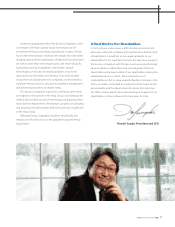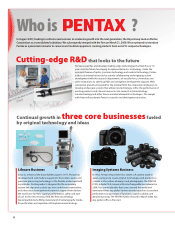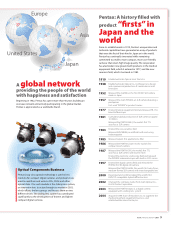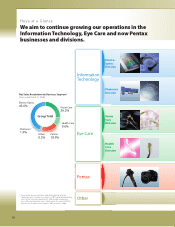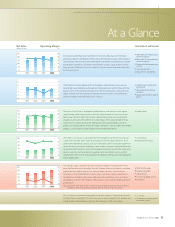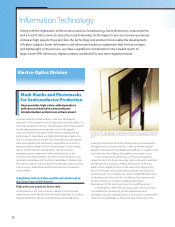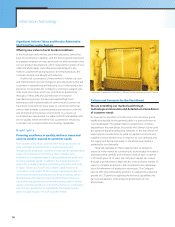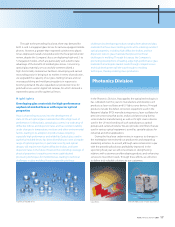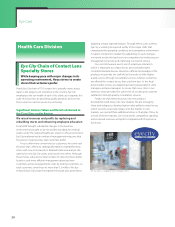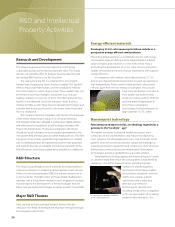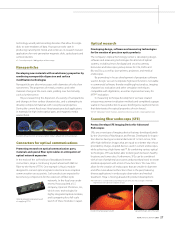Pentax 2008 Annual Report Download - page 19
Download and view the complete annual report
Please find page 19 of the 2008 Pentax annual report below. You can navigate through the pages in the report by either clicking on the pages listed below, or by using the keyword search tool below to find specific information within the annual report.
Through to the preceding fiscal year, there was demand for
both 2- and 3-megapixel glass lenses for camera-equipped mobile
phones. However, a greater-than-expected switchover to plastic
lenses depressed overall units produced in the fiscal period under
review, despite the Company’s focus on deploying high-end 3- to
5-megapixel models, which are particularly well-suited to take
advantage of the benefits of molded glass lenses. Concerning
optical glass materials, we successfully commercialized a
high-functionality material we had been developing and earned
resounding praise in bringing it to market. In terms of production,
we upgraded the capacity of our glass melting furnace and our
overseas polishing and mold pressing plants in response to
booming demand. We also expanded our production lines for
polished lenses used in digital SLR cameras, for which demand is
expected to grow, and for aspherical lenses.
Hoya is channeling resources into the development of
state-of-the-art optical glass materials that offer a high level of
performance. Unlike plastic, optical glass comes in a wide array of
diffractive indices and dispersion rates and has excellent stability
under changes in temperature, moisture and other environmental
factors, leading to its adoption in product areas requiring
especially high performance and reliability. Optical glass used in
aspherical molded lenses has been diversifying to cover a broader
range of optical properties, in particular recently, and optical
designs will require even higher diffractive indices and lower
dispersion rates in the future. However, the extending coverage of
physical properties is requiring ever more sophisticated
processing techniques for molded lenses, leading to technical
challenges in glass molding. Hoya is responding to these
challenges by developing products ranging from advanced glass
materials that have lower melting points while retaining excellent
optical properties, including high diffractive indices and low
dispersion rates to glass materials that present technical
challenges in molding. Through this range, the Company is
promoting development of leading-edge high-performance glass
materials that anticipate market needs through comprehensive
technical development all the way through to molding
techniques, thereby enabling mass production.
In the Photonics Division, Hoya applies the optical technologies it
has cultivated over the years to manufacture and develop such
products as laser oscillators and UV light source devices. Principal
products include the defect correction equipment used in the
flat-panel display (FPD) manufacturing process, laser oscillators for
precision processing that assists analysis aid processing during
semiconductor manufacturing, as well as UV light source devices
used in the UV resin bonding of such optical parts as optical
pickups and camera modules. We also provide color filters that are
used in various optical equipment, as well as specialty glasses for
industrial and other applications.
During the fiscal year under review, in response to changes in
the marketplace we reviewed our product mix and stepped up
marketing activities. As a result, although sales remained on a par
with the preceding fiscal year, profitability improved. In the
upcoming fiscal year, we will concentrate on strengthening
relations with customers and developing products and enhancing
services to meet their needs. Through these efforts, we will strive
to deliver truly valuable solutions to our customers.
Photonics Division
Highlights
Developing glass materials for high-performance
aspherical molded lenses with superior optical
properties
Aspherical molded lenses
EXECURE 4000, a spot UV light source device
Color filters
HOYA ANNUAL REPORT 2008 17


